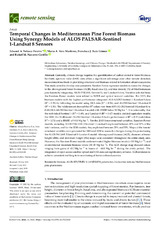Mostrar el registro sencillo del ítem
Temporal changes in mediterranean pine forest biomass using synergy models of ALOS PALSAR-Sentinel 1-Landsat 8 Sensors
| dc.contributor.author | Velasco Pereira, Edward A. | |
| dc.contributor.author | Varo-Martínez, Mª Ángeles | |
| dc.contributor.author | Ruiz Gómez, Francisco José | |
| dc.contributor.author | Navarro Cerrillo, Rafael M. | |
| dc.date.accessioned | 2023-07-14T10:15:07Z | |
| dc.date.available | 2023-07-14T10:15:07Z | |
| dc.date.issued | 2023 | |
| dc.identifier.issn | 2072-4292 | |
| dc.identifier.uri | http://hdl.handle.net/10396/25764 | |
| dc.description.abstract | Currently, climate change requires the quantification of carbon stored in forest biomass. Synthetic aperture radar (SAR) data offers a significant advantage over other remote detection measurement methods in providing structural and biomass-related information about ecosystems. This study aimed to develop non-parametric Random Forest regression models to assess the changes in the aboveground forest biomass (AGB), basal area (G), and tree density (N) of Mediterranean pine forests by integrating ALOS-PALSAR, Sentinel 1, and Landsat 8 data. Variables selected from the Random Forest models were related to NDVI and optical textural variables. For 2015, the biomass models with the highest performance integrated ALS-ALOS2-Sentinel 1-Landsat 8 data (R2 = 0.59) by following the model using ALS data (R2 = 0.56), and ALOS2-Sentinel 1-Landsat 8 (R2 = 0.50). The validation set showed that R2 values vary from 0.55 (ALOS2-Sentinel 1-Landsat 8) to 0.60 (ALS-ALOS2-Sentinel 1-Landsat 8 model) with RMSE below 20 Mg ha−1. It is noteworthy that the individual Sentinel 1 (R2 = 0.49). and Landsat 8 (R2 = 0.47) models yielded equivalent results. For 2020, the AGB model ALOS2-Sentinel 1-Landsat 8 had a performance of R2 = 0.55 (validation R2 = 0.70) and a RMSE of 9.93 Mg ha−1. For the 2015 forest structural variables, Random Forest models, including ALOS PAL-SAR 2-Sentinel 1 Landsat 8 explained between 30% and 55% of the total variance, and for the 2020 models, they explained between 25% and 55%. Maps of the forests’ structural variables were generated for 2015 and 2020 to assess the changes during this period using the ALOS PALSAR 2-Sentinel 1-Landsat 8 model. Aboveground biomass (AGB), diameter at breast height (dbh), and dominant height (Ho) maps were consistent throughout the entire study area. However, the Random Forest models underestimated higher biomass levels (>100 Mg ha−1) and overestimated moderate biomass levels (30–45 Mg ha−1). The AGB change map showed values ranging from gains of 43.3 Mg ha−1 to losses of −68.8 Mg ha−1 during the study period. The integration of open-access satellite optical and SAR data can significantly enhance AGB estimates to achieve consistent and long-term monitoring of forest carbon dynamics. | es_ES |
| dc.format.mimetype | application/pdf | es_ES |
| dc.language.iso | eng | es_ES |
| dc.publisher | MDPI | es_ES |
| dc.rights | https://creativecommons.org/licenses/by/4.0/ | es_ES |
| dc.source | Remote Sens., 15(13), 3430 (2023) | es_ES |
| dc.subject | Biomass | es_ES |
| dc.subject | ALOS | es_ES |
| dc.subject | SENTINEL 1 | es_ES |
| dc.subject | LANDSAT 8 | es_ES |
| dc.subject | Polarization | es_ES |
| dc.subject | Backscatter | es_ES |
| dc.subject | Textures | es_ES |
| dc.subject | Mediterranean pine plantations | es_ES |
| dc.title | Temporal changes in mediterranean pine forest biomass using synergy models of ALOS PALSAR-Sentinel 1-Landsat 8 Sensors | es_ES |
| dc.type | info:eu-repo/semantics/article | es_ES |
| dc.relation.publisherversion | https://doi.org/10.3390/rs15133430 | es_ES |
| dc.relation.projectID | Gobierno de España. RED2018-102719-T | es_ES |
| dc.relation.projectID | Gobierno de España. Ref: 2822/2021 | es_ES |
| dc.relation.projectID | Gobierno de España. Ref: 2822/2021 | es_ES |
| dc.rights.accessRights | info:eu-repo/semantics/openAccess | es_ES |

